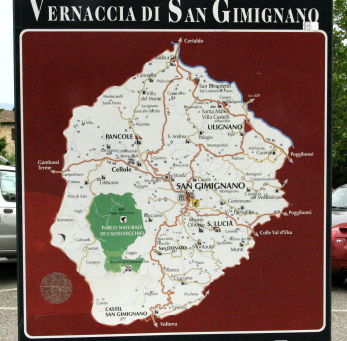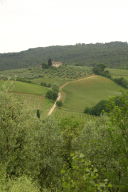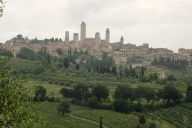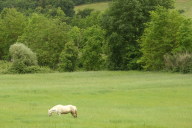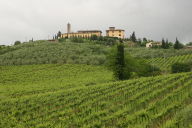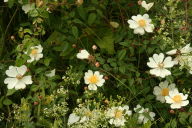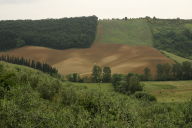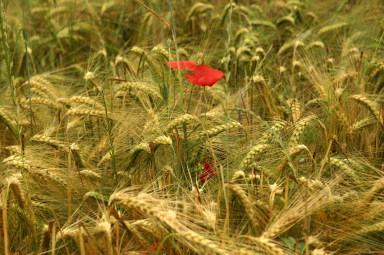Tuesday, the third of June, the
drill this morning was to leave at ten rather than nine,
and by foot rather than by bus. For a while we walked on paved
road, then turned onto a path through fields. Lots of thing to
see and views to photograph all along, though I have to say
that it was a cloudy day again, so the pictures lack some snap.
Around 10:30, I looked back towards San Gimignano and took the
upper picture to the right. Now that’s a hill town!
The picture to the left is just another Tuscan vista, but there
were so many of them, I simply couldn’t resist. But for
the lower shot to the right, I think everybody with a camera
pointed it at the white horse. Just a nice sight.
Neither Mark nor I come from a part of the world where there
are poppies growing wild. So, whether it’s home in California
where we are now living, or here in Europe, the sight of poppies
in the fields, along the roadsides, or anywhere else where nobody
has planted them, gives each of us a kind of thrill. In spite of
this, you’ll notice that I took relatively few poppy pictures.
But the snapshot below is one of those few.
Finally, we met up with the bus and our congenial driver Giovanni,
and drove to San Donato, where we ate at a farm called
Fattoria San Donato
that produces wine and oil. The table in the room we went into was
heavy-laden with cold cuts, cheeses, pickled and fresh vegetables.
All produced right there, and all yummy. We stuffed ourselves, and
then discovered that this was merely antipasto, to be followed of
necessity by some primi piatti, which were ziti with fresh tomatoes
or pesto. Accompanying were Vernaccia and Chianti of house origin.
Since Mark and I both are unconvinced by white wine, we poured only
Chianti for ourselves. There was a cake, too, for today was Ana
Rodríguez’s birthday. Bottles of Vin Santo came out
as well—Mark took a shot of the label—the name refers
to its use as a sacramental wine. It’s sweetish, and you’re
expected to dip biscotti into it.
Because of the weather, I took almost all my pictures before lunch.
And as I recall, I made the mistake of leaving my camera in the bus,
so that I couldn’t take any pictures of the sumptuous meal we
had, nor of the conviviality associated with the birthday celebration.
I kept my camera in its protective Ziploc bag for almost all the rest
of the afternoon, and so I fear that there’s only one more
picture I took that’s good enough to put up here; and even that
isn’t very satisfactory.

Mark, on the other hand, had with him the waterproof camera we bought
for the New Zealand trip, in
case his kayaking skills were not up to par, and waterproof it is
definitely known to be. So
his
page for this day has many more pictures than this page does.
And so, pleasantly replete, we walked away from the Fattoria San Donato,
down into a creek valley, deep though, and back up to Castelvecchio,
a wonderful abandoned hill town. Unfortunately, the weather got uncooperative,
with a light and then a heavier rain. Into the Ziploc bags went the
fancy cameras, not to emerge for quite a while. I did get a picture
of Castelvecchio from a distance (big image,
small), little knowing that this
was the only photographic record of the place that I was going to get
all day. That’s it to the right. Even in the big image, all you
can see is the cracked tower of the town. It was abandoned by 1500, with
little left standing besides the tower than the roofless church, in which
the barest traces of frescoes can be seen in the apse. By the church is
a cistern evidently meant to be filled with rainwater collected off the
church. The town is too high, far from the water table, so that a well
would have been out of the question with the technology of those days.
From there, we walked downhill a bit and then to a plcae where we climbed onto
the bus for a return trip to San Gimignano.
It was a “free dinner” night, and since the lunch had been
so huge, there was no need to go for a fancy big meal. Mark and I chose
an unpretentious trattoria that was almost empty, one couple sitting at
table. (But by the time we left, every table was taken!) Mark chose a
Montepulciano Nobile at €5.00 per glass, and it was amazingly,
superbly, good. I had an Antipasto Tuscano, just a lot of different
cold cuts and a slice of cheese and a couple of crostini. For my primo
piatto, I chose ravioli, which were very nice. No coffee or dessert,
just a choice of gelati at the local gelateria magnifica. Then to bed.
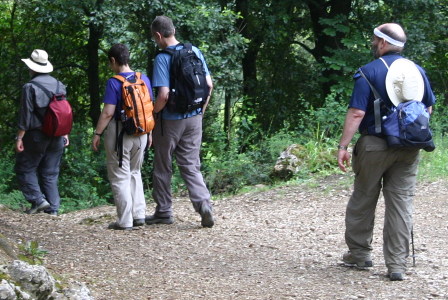
|
Juan, Claire, Glenn, and Mark, on the way down into the creek valley
to get to Castelvecchio. Then the skies opened.
|
